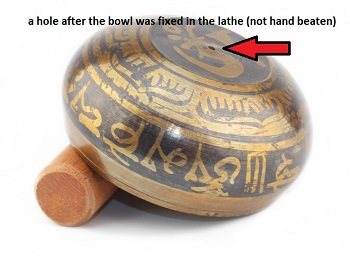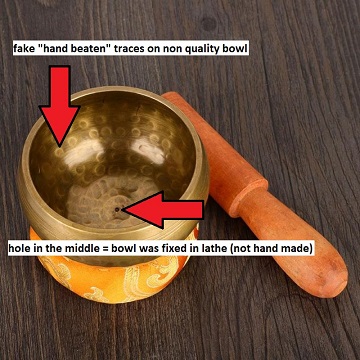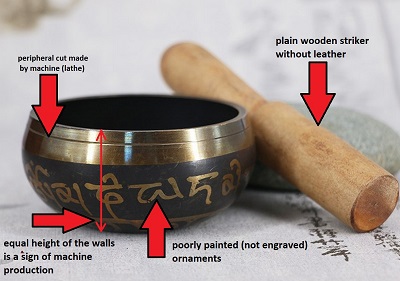How to recognize quality singing bowls?
If you don't have much information about Tibetan bowls and you decide to get one, please read on. It is quite possible that you will be interested in the offers of some sellers who sell so-called Tibetan bowls in a bargain price. If you decide on such a bowl, it may happen that you will be disappointed at the very first blow. And that's even when the bowl looks nice and you got a beautiful gift package with it and it even looks like higher quality and more expensive bowls. It may happen that the sound of the bowl will be flat an expires after just a few seconds. How is it possible? So many books, information on bowls, healers, all for these few seconds?
The main reason cheap bowls and imitations play so short and flat is simple. In particular, Chinese manufacturers, in pursuit of profit and maximizing sales, abuse the reputation of high-quality Tibetan bowls and make their "singing" bowls from low-quality materials and in a way that has nothing to do with the original way of making Tibetan bowls. They use various marketing and production tricks to make the bowls look as attractive as possible, but the essential part, the sound side always lags behind.
- First of all, the composition of a Tibetan bowl should be as follows: 80-85% copper and 15-20% tin. These are the basic raw materials for the production of bronze, from which a high-quality bowl should be forged. Low-quality manufacturers do not follow this ratio and use cheaper substitutes such as zinc and also much less copper, if at all. For example, you will also come across bowls made of cheap and inappropriate aluminum.
- Another reason is the way a Tibetan bowl is made. Low-quality bowls are produced by casting and subsequent turning, whereas the production of original Tibetan bowls is more complicated and longer. From a piece of bronze heated to a high temperature, a group of blacksmiths gradually shapes the bowl by hammering, i.e. hundreds and hundreds of blows until the final shape. This process can take several hours for large bowls and is not easy. It is through beating that the singing bowl acquires its sound quality. You can watch an illustrative video here: https://www.tibetskemisky.sk/production-of-singing-bowls
So how to recognize low-quality bowls?
1. Central hole after holding the lathe.
On low-quality bowls, you can often find a trace of turning in the middle in the form of a small hole from both the inside and the outside. It is the place exactly in the middle of the bowl, where it is attached to the lathe.


2. Circumferential notches.
When turning, perfectly straight decorative notches are often dug into the bowl for more decorative effect. Useless for the sound though.
3. Perfect circular shape of the bowl.
During casting and turning, the excess material is basically removed from the bowl and the bowl thus acquires a perfect circular shape. Also, the sides of the bowl are at exactly the same height and are perfectly straight and the walls are the same height. That is a clear sign of cheap decoration bowl. Real hand-hammered bowls do not have exactly the same wall height and sometimes not even a perfect circular shape.
4. No signs after hand hammering
As mentioned above, it is the beating that gives the bowl a quality sound. Their absence on the plate is not a good sign. Although there are also bowls that were cast and turned and after cooling down, they were only additionally hammered, as you can see in the picture. However, this is just a cosmetic treatment to make them look more authentic.


5. Bowls as an Easter egg.
If you find bowls in different exotic colors, often in the colors of chakras, also pay attention. It is easier to paint a bowl with eye-catching colors than to forge it with quality. It is about the sound, not the color, right?


6. Painted font.
On low-quality bowls, you can often find various painted signs, which is also a signal of mass production. There is a big difference between painting a bowl or painstakingly artistically engraving signs into it.
7. Gift wrapping.
Quality bowls are rarely sold in gift boxes. You will almost always find only an imitation singing bowl inside.


8. Bowl with a wooden mallet without leather coating - free with the bowl.
The mallet offered, which is not covered with leather, bounces off the edges of the bowl while playing and creates an unpleasant sound. The leather on the mallet creates an insulating layer and when circling, but also when striking, the real sound of the bowl can stand out. The value of the mallet lies precisely in the addition of leather, not in the delivery of a piece of wood.


What should quality hand-forged Tibetan singing bowls look like?
- hand-hammered Tibetan bowl - fine traces of hammer blows are visible

- a forged Tibetan bowl may also have slight shape imperfections

- quality decoration - engraving - hollowed out with tools, not painted

- no marks in the center of the bowl after clamping in the lathe

As you can see, high-quality and low-quality bowls can be distinguished relatively easily, and you will avoid unnecessary disappointment and wasted money. All the bowls that you can find in the offer of our e-shop www.tibetskemisky.sk are always and exclusively hand-forged from bronze alloys directly in Nepal or in Northern India, that is, where the production of singing bowls has its own history and tradition and where real craftsmen live and artists who can make quality Tibetan singing bowls.



